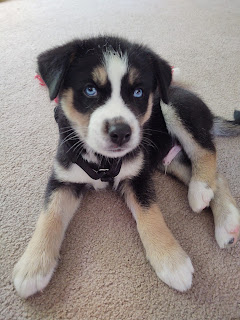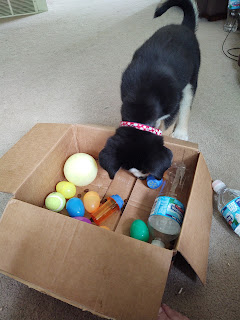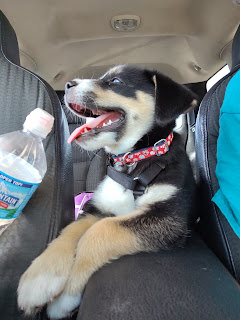Socialization is more about normalization then socializing!
Often people think socialization is meeting lots of new people and dogs, but the term socialization covers a much broader scope. Socializing your puppy means you are providing experiences that they can observe in a safe environment. This applies to anything and everything that is normal in your part of the world. Urban areas may have more traffic sounds and crowds, while urban areas have wildlife noises & critters running across the path. If you live in one area, but frequently visit another you need to socialize or normalize both situations while the puppy is young.
Puppies that you want to be well adjusted adult dogs that can accompany you to pet friendly places need to be socialized to all 5 senses; sight, sound, smell, taste & touch. The window of opportunity to do correct socialization is limited from 8 wks old to 16 wks old. During that critical window you need to expose your pup to a wide variety of objects and environments. Anything you don't expose them to during this time can easily cause fear to set in when they go thru the crazy teen period which typically starts around 8 to 9 months old and lasts till almost 2 yrs old. It's much easier to socialize properly as a puppy then to address fears later in life.
View my socialization list on Google Docs Remember, my dogs are service dogs so this is a large list. But you can download this to Excel and customize it for your surroundings.
Puppies should walk on a wide variety of surfaces including carpet, area rugs, slippery tile floors, air vents, and many more floor surfaces. There is also a ton of outdoor surfaces including grass, dirt roads, stone walks, concrete sidewalks, pavement in parking lots, wood chips, etc. We also practice on unusual surfaces, many of which can be found at a local playground such as slippery slides, wobbly bridges, oddly shaped stairs, and so forth.
They also need to hear a ton of sounds at various volumes. Again playgrounds are a great resource with kids running, swinging, yelling & so much more. We also play a wide variety of movies including Disney movies with lots of singing, animal movies with dogs barking, dragons snorting, farm animals and so on. Right now, my husband is watching the whole Harry Potter series, which is non-stop sounds and background noise. Then in the summer there are typically all kinds of community events including outdoor concerts, parades, and festivals.
Then last but not least, puppies need a wide variety of smells. Household smells include food cooking, various shampoos & lotions, bathroom smells, odors on people & other pets. Hiking trails have the smells of other dogs and wildlife. Pet stores tend to be overwhelming for many puppies because there is simply too many smells for your pup to process. I push scent exposure even farther because my dogs are task trained service dogs to find specific items based on scent. Puppies can be taught how to use their nose. I like to start by teaching puppy how to find the treat in my hand. I will say their name and hand feed them a treat or piece of kibble. If they don't immediately look at you, say their name the pass your hand under their nose. Once they start to pair their name with food, you can use this to develop the early stages of recall.
Games that help with socialization
- Start encouraging my pup to sniff the kibble in my hand. That's it, sniffing leads to treats.
- Next is learning to find kibble in a snuffle box with a few distraction objects.
- Next is figuring out how to find and get to the kibble that is slightly hidden. In this video Azul has a few newspaper balls, each with a few pieces of kibble inside. Azul can use any means possible to find the kibble; unrolling, tearing, dragging, or whatever they want to the newspaper ball. But eventually they figure out the quickest way to get to the food.
Snuffle box
You can build a snuffle box with items commonly found in your house and it's a great way to help your puppy use up some mental energy. With puppies, I will feed a meal this way every few days. Find a cardboard or plastic box that your puppy can easily touch the bottom in. Then put various items in the box such as newspaper balls, crumpled up junk mail, water bottles, plastic lids & bowls, dog toys, knotted up socks, etc. You can use anything that you won't be upset if it gets chewed and won't hurt the puppy if they eat a small piece. Once your box is filled with objects, simply pour your puppies normal kibble in and around the box. You can do a few pieces at a time or the whole meal. If your pup is struggling, reduce the number of items in the box, even backing up to just one item and over several days add in more items. Once pup is used to all the items in the box, start switching out items getting rid of anything that may be damaged and replacing it with something else that is new.
Puppy Obstacle Course
To entertain a curious puppy use common household items to build a puppy obstacle course. Provide lots of different surfaces that your pup can climb on, move around, smell, taste and hear! I love things from my recycle bin;
- cardboard including boxes that have been flattened, boxes sturdy enough for walking on & paper towel rolls.
- Plastic of various shapes, colors & textures including pop bottles, old bowls & lids that no longer have matches, disposable cups.
- Metal cookie sheets and muffin pans.
- The choices are endless!
Put a few different items in your play area. Let pup explore while your calmly supervising nearby. Move things around slowly, rolling balls across flat surfaces & tossing tugs into objects. Just don't get too crazy or move items too fast or you might scare your pup. Switch out 1-2 items a day for new items. Don't want to use any items that you don't want chewed on or heavy items that might fall on your pup. Let pup explore these items for about 10 minutes, then pick them up and put them away for the next session. You do want to make sure your pup has access to puppy toys whenever they are awake. But only do this make shift obstacle course when you can supervise and watch for signs of stress and signs of over excitement. And as always, watch for signs that your pup may need a potty break.



No comments:
Post a Comment